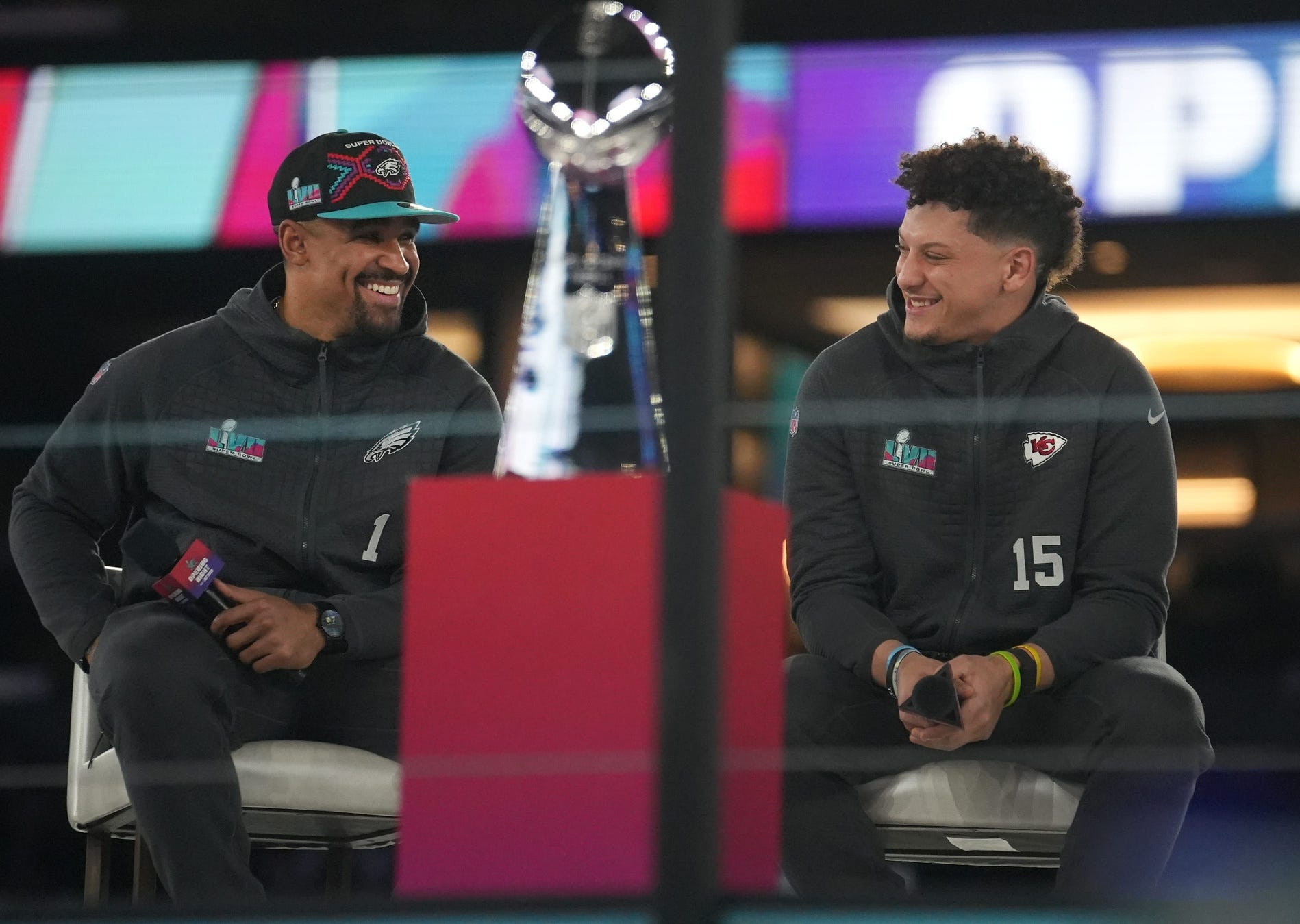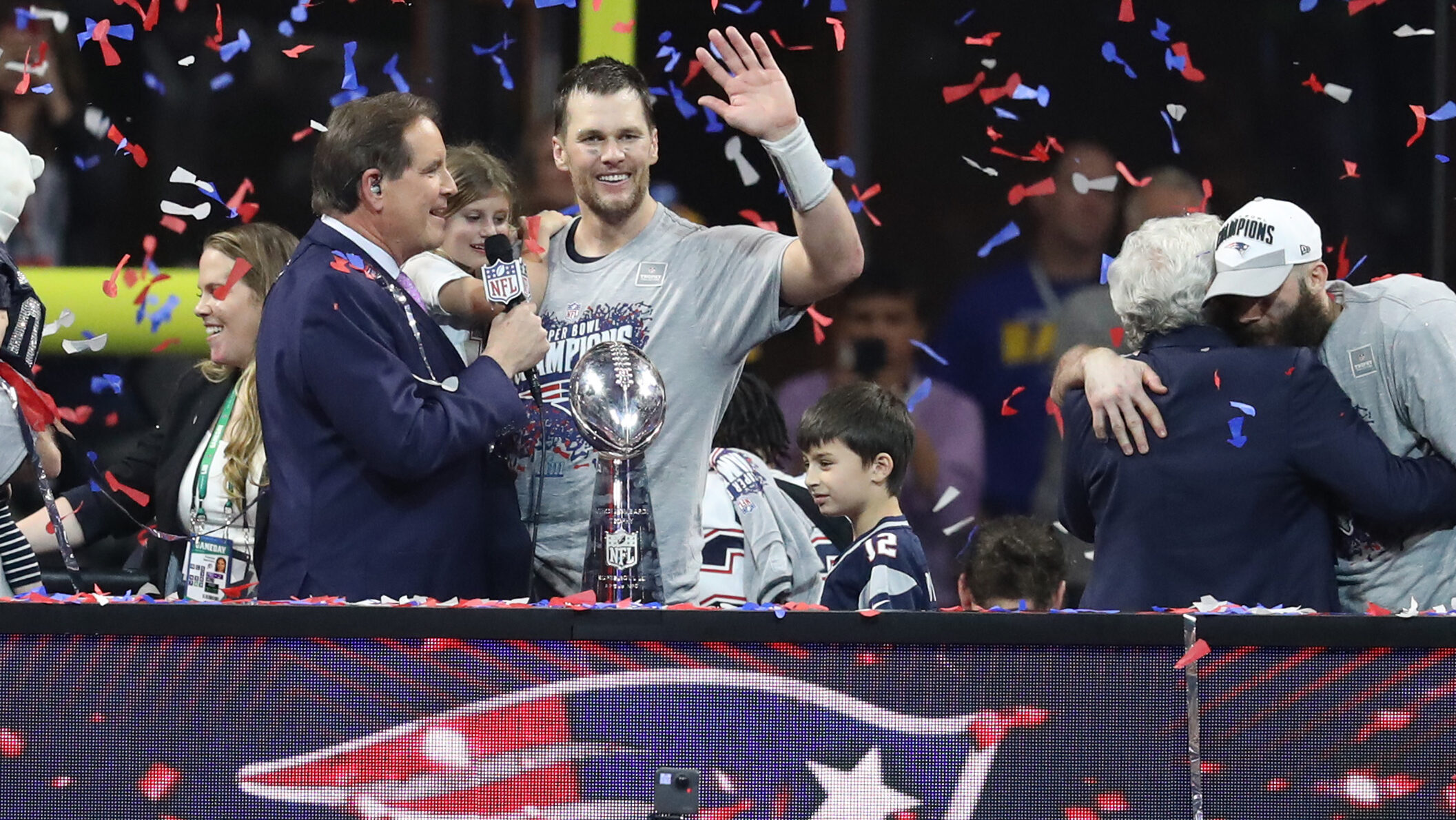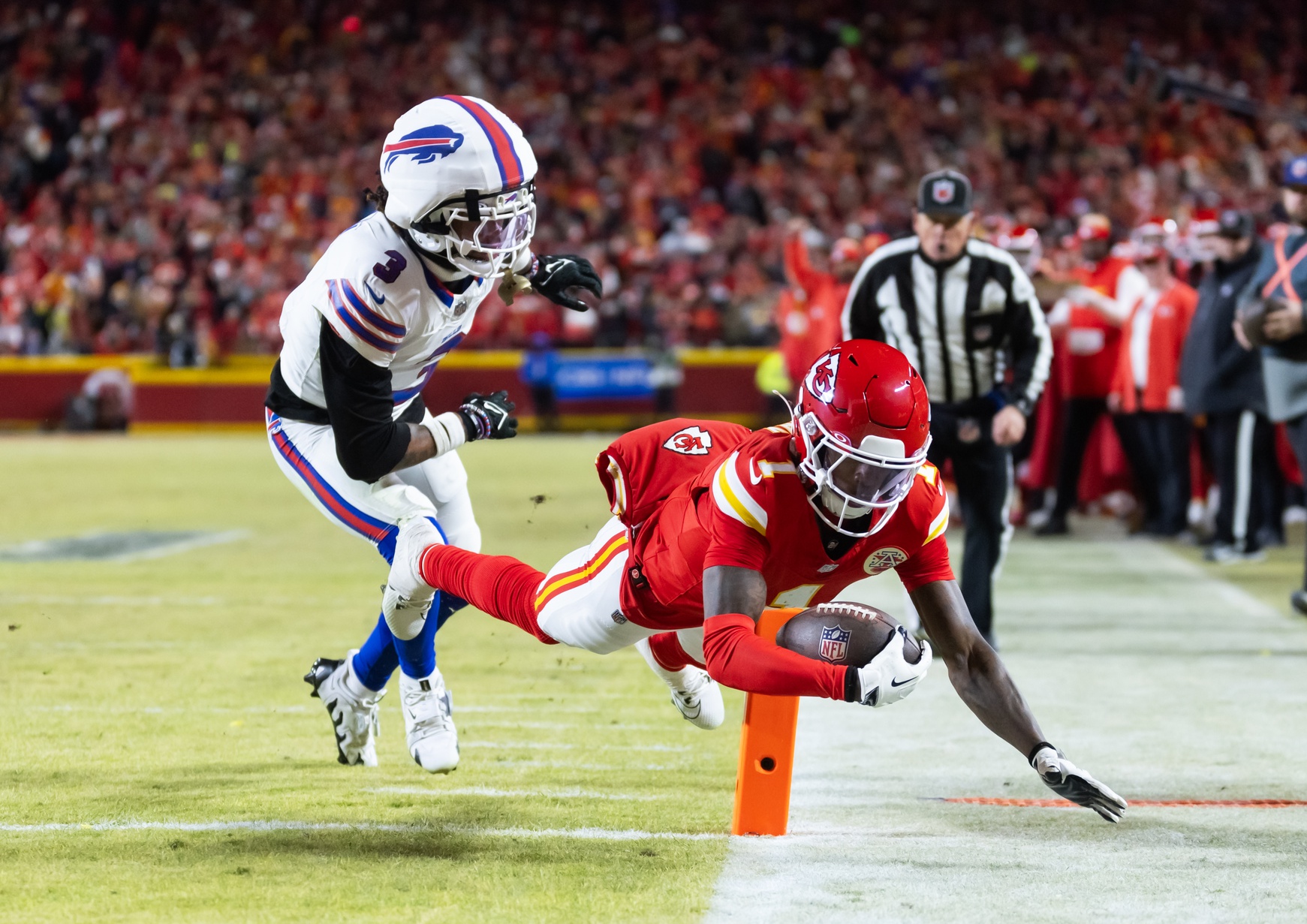NFL Analysis
7/11/24
7 min read
How C.J. Stroud Can Build On Record-Breaking Rookie Season
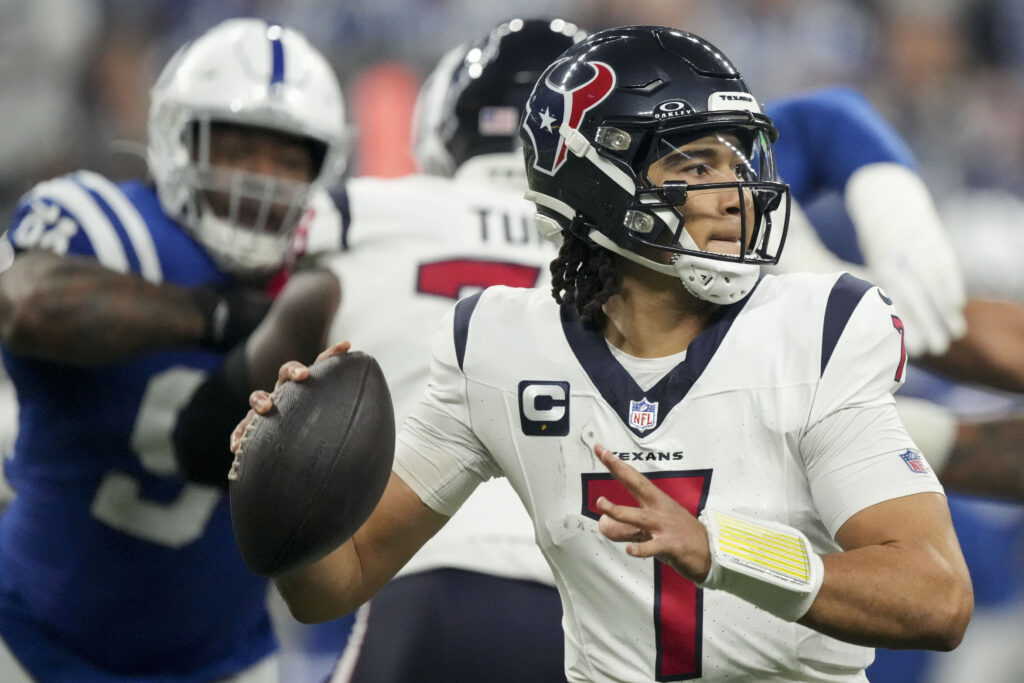
C.J. Stroud is really good. Maybe that’s a spoiler alert for the rest of this article, but that’s undoubtedly the conclusion after one of the best rookie seasons we’ve seen during the past 25 years.
Stroud isn’t perfect, of course, but to dive into him is more to figure out what’s next rather than figuring out if the rookie season production is sustainable.
Season of the sticks
The thing that stands out the most for Stroud — and what made his rookie season so impressive — is that Stroud can and wants to sling the ball. Stroud had five games in 2023 with at least 25 pass attempts and a 10-yard average depth of target, the most in the league. In three of those games, he also had at least 10 yards per attempt, also a league-high figure. Only Dak Prescott also had two last season. No rookie since 2000 has done that more than once.
According to TruMedia, Stroud was the only quarterback to throw more than half of his passes past the first down marker in 2023. In a league that has increasingly relied on short passes and yards after the catch, Stroud was willing to push the ball.
Over the past five seasons, 10 quarterbacks have finished the season with at least 50 percent of their attempts traveling past the sticks. There’s a wide range in the type of quarterback who tried to push the ball, but Stroud stands out not just for being a rookie but also for keeping the ball away from danger while being aggressive.
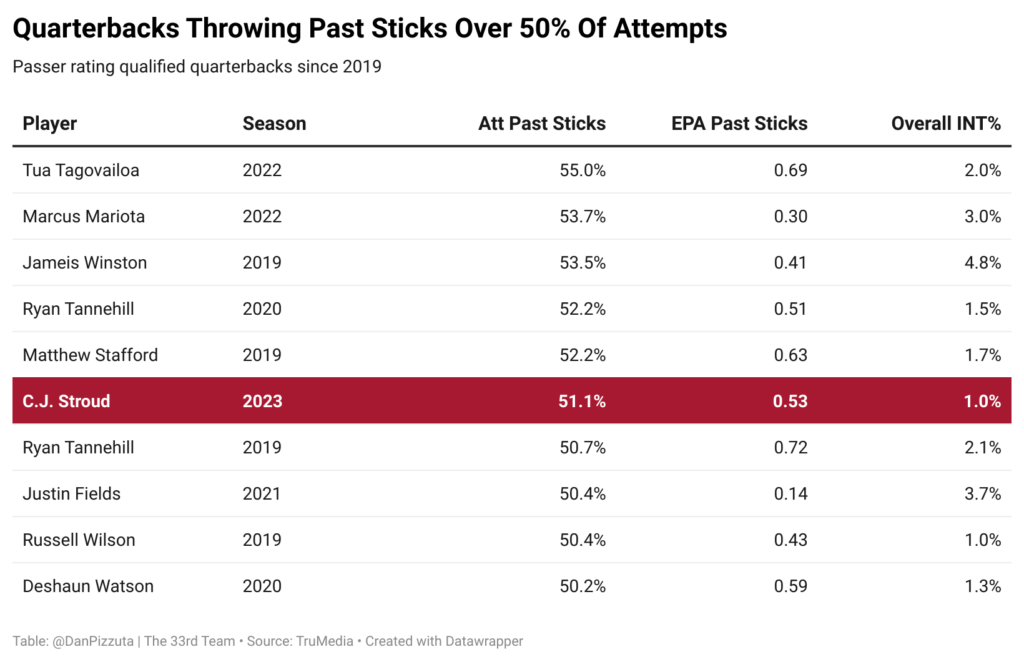
Here is the full list of quarterbacks who averaged an aDOT of at least 9.0 with an interception rate of 1.0 or lower during a season since 2000:
- C.J. Stroud, 2023
End of list.
Stroud knows when to pull the trigger and what is necessary to make that throw a success. His unparalleled level of aggressiveness and accuracy makes his game special.
Even under duress, Stroud is keeping his eyes downfield for the chance at a big play. Since he doesn’t scramble often, his superpower is the ability to buy time in the pocket for these types of plays.
What a ridiculous throw pic.twitter.com/y5VQoP0Z36
— Dan Pizzuta (@DanPizzuta) January 7, 2024
Unlike some of the more traditional “pocket passers,” Stroud uses his time in the pocket to create and allow things to develop. On dropbacks in the pocket without play-action, Stroud had the 12th-highest time to throw and was seventh in EPA per play.
Chaos in the pocket did not phase the rookie quarterback. He was also willing to stand strong and make a throw with a defender in his face.
What a ridiculous throw pt. 2 pic.twitter.com/EFzoYMDrQj
— Dan Pizzuta (@DanPizzuta) January 7, 2024
Controlling the system
Stroud’s aggressiveness fits well in an offense that wants to give the quarterback a ton of answers. With offensive coordinator Bobby Slowik, the Texans are running a Shanahan-style system that opens up spacing in the middle of the field.
Few players are more willing to target the intermediate level of the field, which is the most valuable and the one often opened up by the scheme. Stroud threw 23.8 percent of his passes between 11-19 air yards, second only to Brock Purdy, and he was 11th in EPA per play on those throws.
It’s a marriage of player and scheme that benefits both sides. There were times throughout the season when Stroud’s singular effort either bailed out a bad play or revived the team after an unsuccessful early down run, but there were also times when Stroud was able to do this:
One area where there was a little push and pull in the offense was getting Stroud outside of the pocket. The boot game didn’t always work. On play-action passes that ended outside the pocket, Stroud averaged -0.03 EPA per dropback compared to 0.36 EPA per play on those in the pocket. Some of that came from pressure on naked boots when defenders had a clear path or Stroud. He was pressured on 46.3 percent of his play-action passes outside the pocket, as opposed to 30.6 percent inside.
Stroud is a quarterback who likes to play from the pocket as much as possible. However, with the quality of the offensive line in front of him, that wasn't always available to him. Houston had five different offensive line combinations play at least 100 snaps, tied for the most in the league, and the most common offensive line combination played just 20.2 percent of the Texans’ offensive snaps, the fifth-lowest in the league.
With an improvement in the line, the Texans could keep Stroud in the pocket more often and won’t have to try to boot him out as often, especially since Stroud is not the type of quarterback who needs those types of plays to create space to throw.
Beating Man Coverage
If there is one area where Stroud can improve, it’s against man coverage. Stroud averaged -0.20 EPA per play, which ranked 29th among quarterbacks.

However, he only saw man coverage on 18.8 percent of his dropbacks, which also ranked 29th. All of this is a fairly small sample.
One of the biggest issues came once Tank Dell was injured. That left the Texans without a legitimate second receiving threat again man. On plays against man when Dell and Nico Collins were on the field together, Stroud averaged 0.27 EPA per play with a 50 percent success rate. Those figures would have ranked seventh and sixth, respectively, over a full season.
On any play against man when Dell was not on the field, Stroud averaged -0.31 EPA per play with a 43.9 percent success rate.
This isn’t a shot at Nico Collins, either. Collins was great against man coverage with 4.36 yards per route run. But outside of Collins, there weren’t many man-beaters in the receiving corps. That is going to be the biggest change for 2024. Dell is going to return but the addition of Stefon Diggs could have the biggest impact here.
Diggs has long been able to beat man coverage, and now at least two receivers can beat that type of coverage on the field at the same time on any given play. It will be three receivers when Houston rolls out Collins, Dell, and Diggs in 11 personnel. It won’t be surprising to see Stroud near the bottom of the league in the rate of man coverage faced again because not many defenses have the cornerbacks to hold up against that many quality receivers.
Second-Year Leap?
As the 2023 season went on, the Texans slowly shifted from an offense that was trying to develop and protect a rookie quarterback to one driven completely by Stroud. As the Texans enter the 2024 season, they’ll be able to start at that point and build from there.
From Weeks 1-6, the Texans threw the ball on 51.8 percent of first and second downs, which ranked 24th in the league and was not much of a surprise from a coach who comes directly from the Shanahan tree. But after Houston’s Week 7 bye, the Texans threw on 55.7 percent of early downs, which ranked 12th. That’s giving more control to the quarterback.
Stroud’s strengths in aggressiveness and accuracy put every throw on the table once he drops back. That’s not something that can be said for even some of the top quarterbacks in the league.
It’s easy to get too carried away about what Stroud is and what he can become, but all of the pieces are in place for the second-year passer to build on a level of play that has already placed him among the league’s best.



